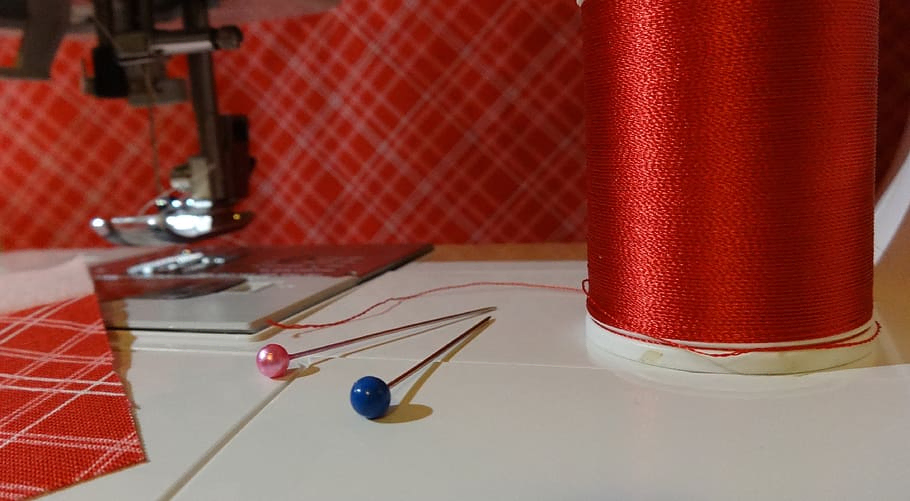Why does my sewing machine skip stitches?

Understanding Skipped Stitches
Skipped stitches can mess up your sewing. Find out the reasons and simple fixes to keep your sewing flawless. Here is the complete guide to understanding why they happen and how to fix them for smooth results.
Why Addressing Skipped Stitches Is Crucial
Repairing missed stitches is essential. Your seams will become weak if you do not do it. Fabric can tear with minimal effort. Missed stitches will give your sewing project a sloppy look. Rectifying this problem will make your sewing projects longer-lasting and prettier. If the issue persists, try adjusting the thread tension or needle placement.
Common Causes of Skipped Stitches
There are a few reasons why a sewing machine might skip stitches. Knowing these causes can help you troubleshoot the problems swiftly. Here are the main reasons for skipped stitches.
Needle Related Problems
Here are a few reasons related to Nedeals
Using an Incorrect Needle Size or Type
The wrong machine needle can cause your machine to skip stitches. Use the correct needle for your fabric. Heavy fabrics require heavy needles, but fragile fabrics require thin needles. Ballpoint needles are better for stretchy fabrics.
Bent or Blunt Needles
A bent or blunt needle can’t pick up the thread effectively. Change your needle frequently, particularly after sewing heavy fabrics or lengthy projects. The seat of the needle should be correctly seated for smooth stitching.
Thread and Tension Issues
Incorrect Threading
If the machine is threaded incorrectly, the upper thread will fail to pick up the fabric and bobin thread. Check your sewing machine’s manual and re-thread the machine as instructed in the steps. If the thread does not pull through the machine smoothly, rechecking the threading process is essential.
Incorrect Thread Tension
If the thread tension is too high or too low, you may skip stitches. Adjust the tension balance according to your fabric type. Pay special attention to the bobbin thread tension, as improper tension here can also cause skipped stitches.
Inferior or Non-Matching Thread
Using low-quality thread or mismatched thread and bobbin thread can cause skipped stitches. Utilize high-quality thread suitable to your fabric type.
Machine Cleaning and Adjustments
Lint Buildup and Dirt
Dust and lint build up in your machine and tension discs, which can cause skipped stitches. Regular cleaning of your sewing machine prevents this.
Inadequate Presser Foot Pressure
When the presser foot pressure is not sufficient, the fabric will not remain in position. Regulate the pressure based on the thickness of the fabric. Try pulling the fabric gently while testing different pressure levels.
Aligned Needle Bar or Hook Timing
A misaligned needle bar or hook timing requires professional repair. If you think this is the problem, have your machine repaired by a technician. See what credentials the technician has before hiring them.
Fabric and Technique Factors
Difficult Fabrics
Slippery or stretchy fabrics have the potential to produce skipped stitches. Sew using the correct needle and slower speed on these types of fabrics.
Technique and Sewing Speed
Sewing too fast can cause skipped stitches. Try sewing at a consistent, slower speed for better results. To achieve the best results, sew at an even, consistent speed. Whichever you prefer, maintain a speed that allows precise stitching.
How to Fix Skipped Stitches
Fixing skipped stitches doesn’t have to be difficult. Follow these pro easy steps to get your sewing machine working perfectly again.
Inspect and Replace the Needle
Check if your needle is bent or dull. Replace the needle if needed. Use the correct type and size for your fabric. Make sure it is inserted all the way.
Rethread the Machine
Completely unthread and rethread the machine properly. Follow your machine’s manual to thread both the upper thread and bobbin thread correctly.
Adjust the Tension Settings
If the stitches look loose or too tight, adjust the thread tension. Test on a scrap fabric piece before sewing your project. Ensure the bobbin thread tension is balanced with the upper thread tension.
Clean and Oil the Machine
Remove lint buildup from the needle plate, bobbin case, and throat plate. Apply sewing machine oil to moving parts as recommended in the manual.
Check the Presser Foot Pressure
Adjust the presser foot pressure based on your fabric thickness. This helps keep the fabric in place while you sew.
Seek Professional Help if Needed
If the issue persists, take your sewing machine to a home repair or technician. They can check for burrs or any internal mechanical issues.
Preventing Skipped Stitches in the Future
Preventing skipped stitches is simpler than repairing them. Use the following tips to prevent the issue in your future sewing projects.
Maintenance of the Machine
Clean your machine after each project. Clear dust and lint from the bobbin case , feed dogs, and needle plate.
Proper Needles and Threads
Always use the right needle size and type for your fabric. Select good-quality thread that suits your fabric type.
Correct Thread Tension and Threading
Inspect your thread tension before commencing any project. Ensure the machine is properly threaded as per the manual.
Practice Good Sewing Habits
Sew steadily. Grip the fabric firmly without tugging it too tightly.
Store Your Machine Properly
Shield your sewing machine from dust by placing it in a clean location and covering it.
When to Seek Professional Help
Sometimes, fixing skipped stitches on your own might not work. It’s important to know when to get professional help.
Persistent Skipping Issues
If your machine often skips stitches, even after you’ve replaced the needle and cleaned it, seek help. A professional can find hidden issues and adjust the bobbin case or needle bar if needed. Home-repair pros can also guide on fixing complex mechanical problems.
Unusual Noises or Jamming
Loud noises or fabric jams could indicate deeper mechanics issues. Stop using the machine and consult a technician to avoid further damage.
Electrical or Digital Machine Problems
If your machine has digital controls or electrical parts, take your machine to an expert who specializes in such repairs. For additional advice, you can also visit the ask-a-doc web sites where professionals discuss work-from-home jobs and other related topics.
Frequently Ask Question
What tension should my sewing machine be on?
The right tension setting on your machine varies with the fabric and thread you’re working with. A tension of 3 to 5 is the norm with most fabrics. Set it higher with heavy fabrics and lower with light fabrics. Test always on scrap fabric to guarantee balanced stitches.
How to tell if thread tension is correct?
The stitches should be even on both sides of the fabric. If the top thread or bobbin thread is too tight or loose, adjust the tension discs.
Why does my needle keep breaking?
A dull needle can cause breakage. Also, check for rough spots on the needle plate or incorrect upper thread tension. If you have tried everything else so far, re-check the threading and tension settings.
If your machine skips stitches despite proper setup, ensure the thread can catch the thread properly through the fabric and machine mechanisms.
